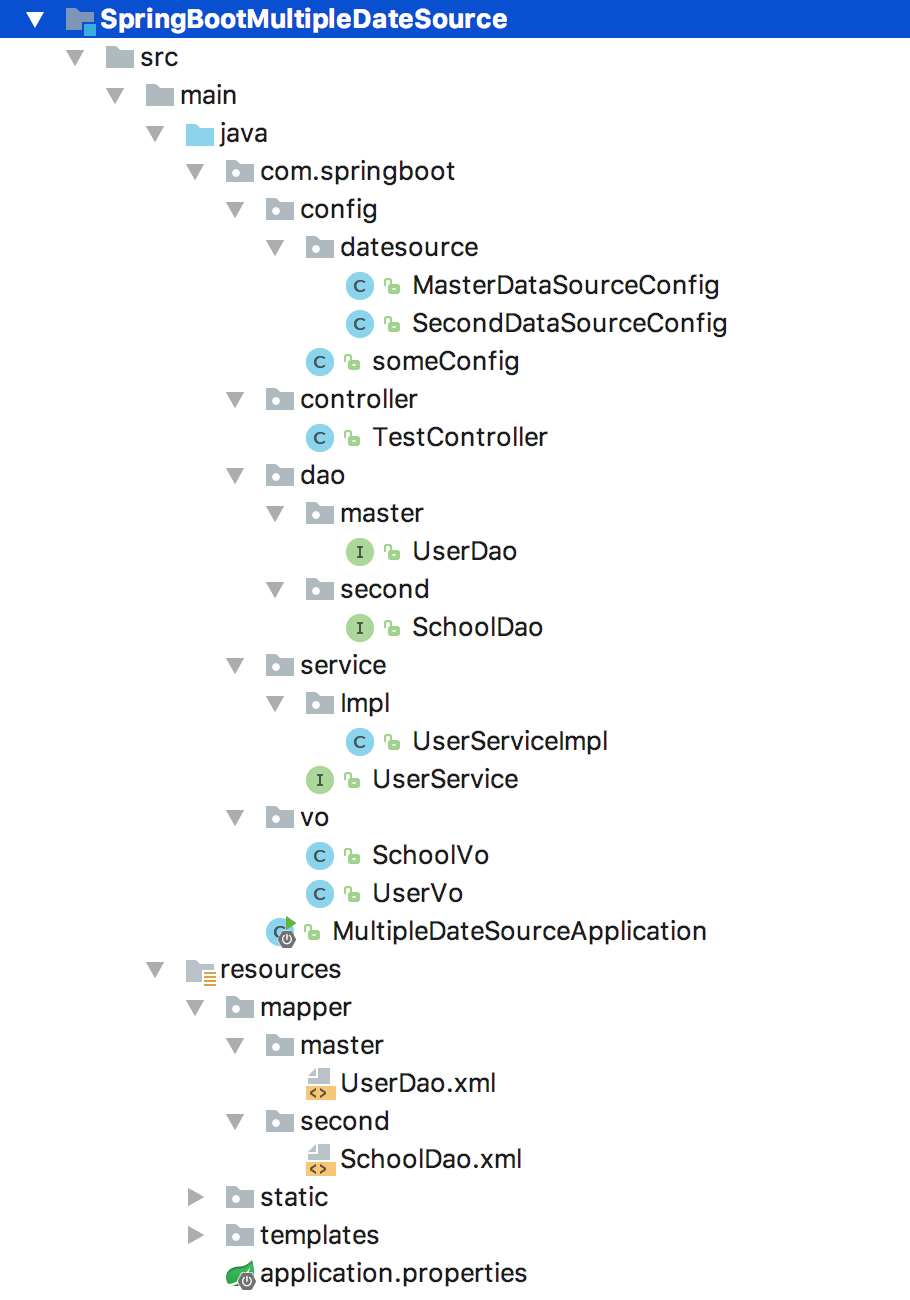SpringBoot and Mybatis configure multiple data sources to connect to multiple databases

Currently Mybatis is the framework for the industry to operate databases, but in many business scenarios, we need to configure multiple data sources in one project to implement business logic.You can also implement multiple data sources in SpringBoot and write xml files to execute SQL with the Mybatis framework.In SpringBoot, it's easy to configure multiple data sources.
Start with code below:
- Some dependencies need to be added to the pom.xml file
<!-- Spring Boot Mybatis rely on --> <dependency> <groupId>org.mybatis.spring.boot</groupId> <artifactId>mybatis-spring-boot-starter</artifactId> <version>1.2.0</version> </dependency> <!-- MySQL Connection Driven Dependency --> <dependency> <groupId>mysql</groupId> <artifactId>mysql-connector-java</artifactId> <version>5.1.39</version> </dependency> <!-- Druid Data Connection Pool Dependency --> <dependency> <groupId>com.alibaba</groupId> <artifactId>druid</artifactId> <version>1.0.18</version> </dependency>
- application.properties Configuration Two data source configurations
# master data source configuration master.datasource.url=jdbc:mysql://localhost:3306/springbootdb?useUnicode=true&characterEncoding=utf8 master.datasource.username=root master.datasource.password=321 master.datasource.driverClassName=com.mysql.jdbc.Driver # Seconds data source configuration second.datasource.url=jdbc:mysql://localhost:3306/springbootdb_second?useUnicode=true&characterEncoding=utf8 second.datasource.username=root second.datasource.password=321 second.datasource.driverClassName=com.mysql.jdbc.Driver
- Data Source Configuration
When configuring multiple data sources, be aware that there must be one primary data source, the MasterDataSourceConfig configuration
- @Primary Flag this Bean if it is preferred when there are multiple candidates of the same type."When configuring multiple data sources, it is important to have a primary data source that uses @Primary Flag the Bean
- @MapperScan scans the Mapper interface and manages containers, with package paths precisely to master, to distinguish it from the following cluster data sources
- @Value Gets the kv configuration for the global profile application.properties and automatically assembles the sqlSessionFactoryRef representation to define a key, representing a unique SqlSessionFactory instance
Code for MasterDataSourceConfig:
@Configuration // Scan Mapper interfaces and container management @MapperScan(basePackages = MasterDataSourceConfig.PACKAGE, sqlSessionFactoryRef = "masterSqlSessionFactory") public class MasterDataSourceConfig { // Precise to master directory to isolate from other data sources static final String PACKAGE = "org.spring.springboot.dao.master"; static final String MAPPER_LOCATION = "classpath:mapper/master/*.xml"; @Value("${master.datasource.url}") private String url; @Value("${master.datasource.username}") private String user; @Value("${master.datasource.password}") private String password; @Value("${master.datasource.driverClassName}") private String driverClass; @Bean(name = "masterDataSource") @Primary public DataSource masterDataSource() { DruidDataSource dataSource = new DruidDataSource(); dataSource.setDriverClassName(driverClass); dataSource.setUrl(url); dataSource.setUsername(user); dataSource.setPassword(password); return dataSource; } @Bean(name = "masterTransactionManager") @Primary public DataSourceTransactionManager masterTransactionManager() { return new DataSourceTransactionManager(masterDataSource()); } @Bean(name = "masterSqlSessionFactory") @Primary public SqlSessionFactory masterSqlSessionFactory(@Qualifier("masterDataSource") DataSource masterDataSource) throws Exception { final SqlSessionFactoryBean sessionFactory = new SqlSessionFactoryBean(); sessionFactory.setDataSource(masterDataSource); sessionFactory.setMapperLocations(new PathMatchingResourcePatternResolver() .getResources(MasterDataSourceConfig.MAPPER_LOCATION)); return sessionFactory.getObject(); } }
The second data source, SecondDataSourceConfig, is configured as follows:
@Configuration // Scan Mapper interfaces and container management @MapperScan(basePackages = SecondDataSourceConfig.PACKAGE, sqlSessionFactoryRef = "secondSqlSessionFactory") public class SecondDataSourceConfig { // Precise to the cluster directory to isolate from other data sources static final String PACKAGE = "com.springboot.dao.second"; static final String MAPPER_LOCATION = "classpath:mapper/second/*.xml"; @Value("${second.datasource.url}") private String url; @Value("${second.datasource.username}") private String user; @Value("${second.datasource.password}") private String password; @Value("${second.datasource.driverClassName}") private String driverClass; @Bean(name = "secondDataSource") public DataSource clusterDataSource() { DruidDataSource dataSource = new DruidDataSource(); dataSource.setDriverClassName(driverClass); dataSource.setUrl(url); dataSource.setUsername(user); dataSource.setPassword(password); return dataSource; } @Bean(name = "secondTransactionManager") public DataSourceTransactionManager clusterTransactionManager() { return new DataSourceTransactionManager(clusterDataSource()); } @Bean(name = "secondSqlSessionFactory") public SqlSessionFactory clusterSqlSessionFactory(@Qualifier("secondDataSource") DataSource clusterDataSource) throws Exception { final SqlSessionFactoryBean sessionFactory = new SqlSessionFactoryBean(); sessionFactory.setDataSource(clusterDataSource); sessionFactory.setMapperLocations(new PathMatchingResourcePatternResolver() .getResources(SecondDataSourceConfig.MAPPER_LOCATION)); return sessionFactory.getObject(); } }
Now that the different data source configurations have been completed, all that remains is to write the xml file for Mybatis and the interface for the DAO layer, inject it into the Service layer, and use it directly.
Code for the Service layer:
@Service public class UserServiceImpl implements UserService { @Autowired private UserDao userDao; @Autowired private SchoolDao schoolDao; public UserVo getUser(Long id) { UserVo userVo = userDao.findById(id); SchoolVo schoolVo = schoolDao.findByName("tsinghua"); userVo.setSchoolVo(schoolVo); return userVo; } }
The contents of Mybatis's XML file UserDao.xml and ChoolDao.xml:
UserDao.xml
<?xml version="1.0" encoding="UTF-8" ?> <!DOCTYPE mapper PUBLIC "-//mybatis.org//DTD Mapper 3.0//EN" "http://mybatis.org/dtd/mybatis-3-mapper.dtd" > <mapper namespace="com.springboot.dao.master.UserDao"> <resultMap id="BaseResultMap" type="com.springboot.vo.UserVo"> <result column="id" property="id" /> <result column="user_name" property="userName" /> </resultMap> <sql id="Base_Column_List"> id, user_name </sql> <select id="findById" resultMap="BaseResultMap" parameterType="java.lang.Long"> select <include refid="Base_Column_List" /> from user where id = #{id} </select> </mapper>
SchoolDao.xml
<?xml version="1.0" encoding="UTF-8" ?> <!DOCTYPE mapper PUBLIC "-//mybatis.org//DTD Mapper 3.0//EN" "http://mybatis.org/dtd/mybatis-3-mapper.dtd" > <mapper namespace="com.springboot.dao.second.SchoolDao"> <resultMap id="BaseResultMap" type="com.springboot.vo.SchoolVo"> <result column="id" property="id" /> <result column="school_name" property="schoolName" /> <result column="school_describe" property="schoolDescribe" /> </resultMap> <sql id="Base_Column_List"> id, school_name, school_describe </sql> <select id="findByName" resultMap="BaseResultMap" parameterType="java.lang.String"> select <include refid="Base_Column_List" /> from school where school_name = #{schoolName} </select> </mapper>
TestController
@Controller @RequestMapping(value = "/api/v1/test") public class TestController { @Autowired private UserService userService; @RequestMapping(value = "/getUser") @ResponseBody public UserVo getUser(@RequestParam(value = "id") Long id) { return userService.getUser(id); } }
Create a database and table SQL:
CREATE DATABASE springbootdb; CREATE DATABASE springbootdb_second; CREATE TABLE `user` ( `id` int(10) unsigned NOT NULL AUTO_INCREMENT COMMENT 'User Number', `user_name` varchar(25) DEFAULT NULL COMMENT 'User Name', `description` varchar(25) DEFAULT NULL COMMENT 'describe', PRIMARY KEY (`id`) ) ENGINE=InnoDB AUTO_INCREMENT=2 DEFAULT CHARSET=utf8 CREATE TABLE `school` ( `id` bigint(20) NOT NULL, `school_name` varchar(64) DEFAULT NULL COMMENT 'School Name', `school_describe` varchar(128) DEFAULT NULL COMMENT 'School Description', PRIMARY KEY (`id`) ) ENGINE=InnoDB DEFAULT CHARSET=utf8 insert into `springbootdb`.`user` ( `user_name`, `description`) values ( 'shuai', 'so handsome'); insert into `springbootdb_second`.`school` ( `id`, `school_name`, `school_describe`) values ( '1', 'tsinghua', 'Constant self-reliance, good carrier');
Once the data has been created, the organization for the entire project is as follows:
Start the program and enter: http://localhost:8080/api/v1/test/getUser?id=1 returns the result.

github address: Spring Boot Tutorial, Technology Stack, Sample Code
